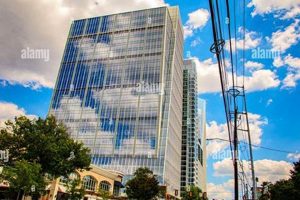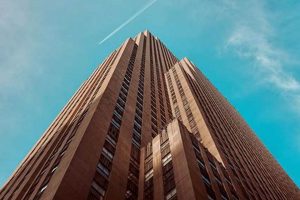A skyscraper is a continuously habitable high-rise building having multiple floors and a height that is considerably taller than other nearby buildings. The term “skyscraper” is generally applied to buildings having over 40 floors and rising at least 150 metres (492 feet) in height, though there is no universally accepted definition.
Skyscrapers are important because they allow for a more efficient use of land in densely populated urban areas. They also provide tenants with a variety of amenities and services that may not be available in other types of buildings, such as on-site dining, fitness centers, and conference rooms. Additionally, skyscrapers can be iconic landmarks that contribute to the identity of a city.
The first skyscrapers were built in the late 19th century in Chicago and New York City. Since then, skyscrapers have been built in cities all over the world. Some of the most famous skyscrapers include the Empire State Building in New York City, the Petronas Towers in Kuala Lumpur, and the Burj Khalifa in Dubai.
1. Height
Height is one of the most defining characteristics of a skyscraper. The Council on Tall Buildings and Urban Habitat (CTBUH) defines a skyscraper as a building that is at least 150 meters (492 feet) tall. However, most skyscrapers are much taller than this, with many of the tallest skyscrapers in the world being over 500 meters tall.
The height of a skyscraper is important for a number of reasons. First, it allows for a more efficient use of land in densely populated urban areas. By building up instead of out, skyscrapers can accommodate more people and businesses in a smaller footprint. Second, the height of a skyscraper can provide tenants with breathtaking views of the surrounding cityscape. Third, the height of a skyscraper can be a status symbol, reflecting the wealth and power of the city in which it is built.
The construction of tall skyscrapers is a complex and challenging process. Engineers and architects must carefully consider the structural integrity of the building, as well as the wind loads and seismic forces that it will be subjected to. In addition, the construction of tall skyscrapers requires the use of specialized equipment and techniques.
Despite the challenges, the construction of tall skyscrapers continues to push the boundaries of architectural design and engineering. Skyscrapers are an essential part of the modern urban landscape, and they play a vital role in the economic and social life of cities.
2. Density
Density is an important consideration in the design and construction of skyscrapers. The density of a skyscraper refers to the amount of space that is occupied by the building in relation to the amount of land that it is built on. Skyscrapers are typically built in densely populated urban areas, where land is scarce and expensive. As a result, skyscrapers must be designed to accommodate a large number of people and businesses in a relatively small footprint.
- Land Use
The density of a skyscraper can have a significant impact on the way that land is used in urban areas. By building up instead of out, skyscrapers can help to preserve valuable land for other uses, such as parks, green space, and affordable housing.
- Transportation
The density of a skyscraper can also affect transportation patterns in urban areas. Skyscrapers can help to reduce traffic congestion by providing workers and residents with easy access to public transportation and other transportation options.
- Sustainability
The density of a skyscraper can also have a positive impact on the environment. By reducing the amount of land that is used for development, skyscrapers can help to preserve natural habitats and reduce greenhouse gas emissions.
The density of a skyscraper is a complex issue that must be carefully considered by architects and urban planners. However, when done , high-density development can be a sustainable and efficient way to use land in urban areas.
3. Design
The design of a skyscraper is a complex and challenging process that requires the collaboration of architects, engineers, and other professionals. The design of a skyscraper must take into account a number of factors, including the building’s height, weight, and function. The design must also be aesthetically pleasing and the surrounding environment.
- Structural Design
One of the most important aspects of skyscraper design is the structural design. The structural design of a skyscraper must be able to withstand the weight of the building, as well as the wind loads and seismic forces that it will be subjected to. The structural design of a skyscraper is typically based on a steel frame, which is then reinforced with concrete or other materials.
- Architectural Design
The architectural design of a skyscraper is also important, as it can affect the building’s overall appearance and function. The architectural design of a skyscraper typically includes the building’s facade, which is the exterior of the building, as well as the building’s interior design.
- Functional Design
The functional design of a skyscraper is also important, as it can affect the building’s usability and efficiency. The functional design of a skyscraper typically includes the building’s floor plan, which is the layout of the building’s interior, as well as the building’s mechanical systems, which are the systems that provide the building with power, water, and other essential services.
- Sustainable Design
The sustainable design of a skyscraper is also important, as it can affect the building’s environmental impact. The sustainable design of a skyscraper typically includes the use of energy-efficient materials and systems, as well as the use of renewable energy sources.
The design of a skyscraper is a complex and challenging process that requires the collaboration of architects, engineers, and other professionals. However, when done well, the design of a skyscraper can result in a building that is both beautiful and functional.
4. Function
The function of a skyscraper is to provide space for people to live, work, and shop. Skyscrapers are typically used for commercial purposes, such as office space, retail space, and hotel space. However, skyscrapers can also be used for residential purposes, such as apartments and condominiums.
The function of a skyscraper has a signi
ficant impact on its design. For example, a skyscraper that is used for office space will have a different design than a skyscraper that is used for residential purposes. Office skyscrapers typically have large, open floor plans that can accommodate a large number of workers. Residential skyscrapers, on the other hand, typically have smaller, more private units that are designed for families and individuals.
The function of a skyscraper also has a significant impact on its construction. For example, a skyscraper that is used for office space will require a different type of foundation than a skyscraper that is used for residential purposes. Office skyscrapers typically have a deeper foundation that is designed to support the weight of a large number of people and equipment. Residential skyscrapers, on the other hand, typically have a shallower foundation that is designed to support the weight of a smaller number of people and belongings.
The function of a skyscraper is an important consideration for architects and engineers. The function of a skyscraper will determine its design, construction, and overall appearance.
5. Construction
The construction of a skyscraper is a complex and challenging process that requires the collaboration of architects, engineers, and other professionals. The construction of a skyscraper typically takes several years to complete, and it can cost hundreds of millions of dollars.
The first step in the construction of a skyscraper is to excavate the site and build the foundation. The foundation of a skyscraper is typically a large concrete slab that is designed to support the weight of the building. Once the foundation is complete, the steel frame of the skyscraper is erected. The steel frame is the backbone of the skyscraper, and it provides the building with its strength and stability.
Once the steel frame is complete, the exterior of the skyscraper is constructed. The exterior of a skyscraper is typically made of glass, metal, or concrete. The exterior of the skyscraper must be designed to withstand the wind loads and seismic forces that it will be subjected to.Once the exterior of the skyscraper is complete, the interior of the building is constructed. The interior of a skyscraper is typically divided into floors, which are connected by elevators and stairwells. The interior of a skyscraper must be designed to meet the needs of the building’s tenants, and it must include all of the necessary amenities, such as restrooms, kitchens, and conference rooms.
The construction of a skyscraper is a complex and challenging process, but it is also a rewarding one. Skyscrapers are an essential part of the modern urban landscape, and they play a vital role in the economic and social life of cities.
6. Sustainability
Sustainability is an increasingly important consideration in the design and construction of skyscrapers. Skyscrapers are large, complex buildings that can have a significant impact on the environment, both during their construction and during their operation. As a result, architects and engineers are increasingly looking for ways to make skyscrapers more sustainable.
There are a number of ways to make skyscrapers more sustainable. One important strategy is to use energy-efficient materials and systems. For example, skyscrapers can be equipped with energy-efficient lighting, heating, and cooling systems. Additionally, skyscrapers can be designed to take advantage of natural light and ventilation, which can reduce the need for artificial lighting and air conditioning.
Another important strategy for making skyscrapers more sustainable is to reduce their water consumption. This can be done by installing low-flow fixtures and appliances, and by using rainwater harvesting systems to collect and reuse rainwater. Additionally, skyscrapers can be designed to include green roofs and walls, which can help to reduce stormwater runoff and improve air quality.
Finally, it is important to consider the embodied energy of skyscrapers. Embodied energy is the energy that is used to extract, process, and transport the materials that are used to construct a building. Skyscrapers are typically made of steel, concrete, and glass, all of which are energy-intensive materials to produce. As a result, it is important to carefully consider the materials that are used to construct skyscrapers and to choose materials that have a low embodied energy.
By using sustainable design and construction practices, architects and engineers can create skyscrapers that are more environmentally friendly and that have a lower impact on the environment.
7. History
Skyscrapers are a relatively recent invention, with the first true skyscraper being built in Chicago in 1885. However, the history of skyscrapers can be traced back to the early days of human civilization. The first buildings for which the term “skyscraper” was applied arose in the ancient world in an attempt to reach towards the heavens as a display of dominance and grandeur. Towers and multi-level structures were being built in the Middle East, Asia, and Europe well before the 19th century. These early skyscrapers were often built for religious or military purposes, and they were often the tallest buildings in their respective cities.
The development of the modern skyscraper was made possible by a number of factors, including the invention of the elevator, the development of new building materials, and the growth of cities. The first elevator was invented in 1852, and it quickly became an essential feature of skyscrapers. New building materials, such as steel and concrete, also made it possible to build taller and stronger buildings. And the growth of cities created a demand for more space, which led to the construction of taller buildings.
Skyscrapers have had a profound impact on the way that we live and work. They have allowed us to build cities that are denser and more efficient. Skyscrapers have also become iconic symbols of cities, and they are often used to represent the power and prosperity of a city.
Skyscraper FAQs
Skyscrapers are an essential part of the modern urban landscape. They are marvels of engineering and architectural ingenuity, and they play a vital role in the economic and social life of cities. However, there are also a number of common concerns and misconceptions about skyscrapers.
Question 1: Are skyscrapers safe?
Skyscrapers are designed to be safe and withstand high winds, earthquakes, and other natural disasters. They are built with strong materials, such as steel and concrete, and they have a variety of safety features, such as fire sprinklers and emergency exits.
Question 2: Are skyscrapers energy efficient?
Skyscrapers can be energy efficient, but it depends on the design of the building. Some skyscrapers are equipped with energy-efficient lighting, heating, and cooling systems. Additionally, skyscrapers can be designed to take advantage of natural light and ventilation, which can reduce the need for artificial lighting and air conditioning.
Question 3: Are skyscrapers bad for the environment?
Skyscrapers can have a negative impact on the environmen
t, but this depends on how they are built and operated. Skyscrapers that are constructed with sustainable materials and operated efficiently can have a lower environmental impact than other types of buildings.
Question 4: Are skyscrapers a good investment?
Skyscrapers can be a good investment, but it depends on the location of the building and the current real estate market. Skyscrapers in desirable locations can be very valuable, but they can also be expensive to build and maintain.
Question 5: What is the tallest skyscraper in the world?
The tallest skyscraper in the world is the Burj Khalifa in Dubai, United Arab Emirates. The Burj Khalifa is 828 meters (2,717 feet) tall and has 163 floors.
Question 6: What is the future of skyscrapers?
The future of skyscrapers is bright. As cities continue to grow, there will be a need for more space-efficient buildings. Skyscrapers are becoming more sustainable and energy-efficient, and they are increasingly being used for mixed-use purposes, such as residential, commercial, and retail.
Skyscrapers are an important part of the modern urban landscape, and they will continue to play a vital role in the economic and social life of cities.
Skyscraper Tips
Skyscrapers are an essential part of the modern urban landscape. They are marvels of engineering and architectural ingenuity, and they play a vital role in the economic and social life of cities. However, there are also a number of challenges associated with the design, construction, and operation of skyscrapers.
Here are five tips for designing, constructing, and operating skyscrapers:
Tip 1: Consider the local context
Skyscrapers should be designed to complement the surrounding environment. They should be in scale with the neighboring buildings and should respect the local culture and history.Tip 2: Use sustainable materials and construction methods
Skyscrapers can have a significant impact on the environment. Architects and engineers should use sustainable materials and construction methods to reduce the environmental impact of skyscrapers.Tip 3: Design for safety and security
Skyscrapers must be designed to be safe and secure. They should be able to withstand high winds, earthquakes, and other natural disasters. They should also be designed to prevent crime and terrorism.Tip 4: Create a variety of spaces
Skyscrapers should offer a variety of spaces to meet the needs of tenants and visitors. This can include office space, retail space, residential space, and public space.Tip 5: Consider the long-term impact
Skyscrapers are long-term investments. Architects and engineers should consider the long-term impact of their designs on the city and the environment.
By following these tips, architects and engineers can design, construct, and operate skyscrapers that are safe, sustainable, and beautiful.
Skyscrapers are an important part of the modern urban landscape, and they will continue to play a vital role in the economic and social life of cities. By following these tips, architects and engineers can create skyscrapers that are safe, sustainable, and beautiful.
Skyscrapers
Skyscrapers are an essential part of the modern urban landscape. They are marvels of engineering and architectural ingenuity, and they play a vital role in the economic and social life of cities. Skyscrapers provide much-needed space for businesses, residents, and visitors, and they can help to create a more vibrant and sustainable urban environment.
The future of skyscrapers is bright. As cities continue to grow, there will be a need for more space-efficient buildings. Skyscrapers are becoming more sustainable and energy-efficient, and they are increasingly being used for mixed-use purposes, such as residential, commercial, and retail. Skyscrapers are also becoming more resilient, as they are being designed to withstand the effects of climate change and other natural disasters.
Skyscrapers are an important part of the future of urban living. They can help to create more livable, sustainable, and resilient cities.







